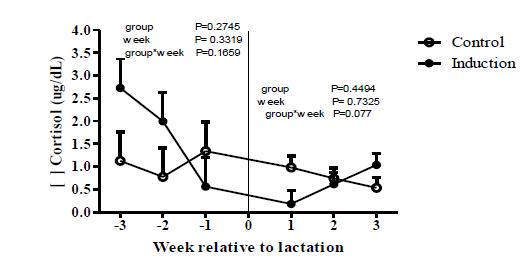ABSTRACT
The aim of this study was to evaluate the metabolic, inflammatory, and hepatic aspects, as well as the milk yield in heifers submitted to protocol for induction of lactation compared to primiparous cows. Sixty Holstein heifers were selected and enrolled into two groups: Control (n= 30), pregnant heifers and Induction heifers (n= 30), non-pregnant femeales, submitted to a lactation induction protocol. Blood samples were collected at: pre-lactation period (weeks -3, -2 and -1) and post-lactation period (weeks 1, 2 and 3), aiming to evaluate glucose, non-esterified fatty acids, paraoxonase-1, albumin, ALT, GGT and cortisol. The protocol efficiently induced lactation in all the heifers, which produced 74.54% of the total production of milk from primiparous cows. In the pre-lactation period, induced animals presented higher concentrations of non-esterified fatty acids than the Control heifers, and the opposite was observed in the post lactation period. In both moments albumin and ALT were lower in the Induction group, and paraoxonase-1 activity and GGT concentrations were higher, compared to the Control. Thus, lactation induction protocol is efficient to initiate milk production in dairy heifers with no considerable changes in energetic, metabolic and hepatic profile when compared to heifers in physiological lactation.
Keywords:
energetic status; hepatic profile; hormonal protocol; inflammatory

 ) and induced (
) and induced ( ) heifers during pre-lactation (weeks -3, -2, -1) and post -lactation (weeks 1, 2 and 3).
) heifers during pre-lactation (weeks -3, -2, -1) and post -lactation (weeks 1, 2 and 3).






